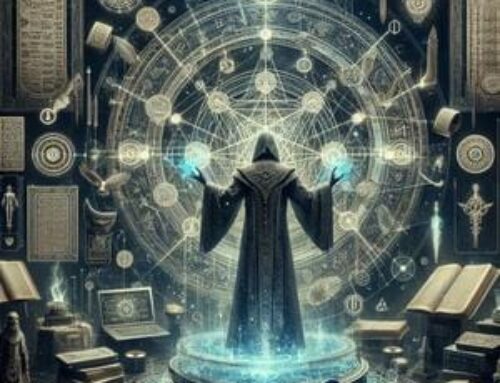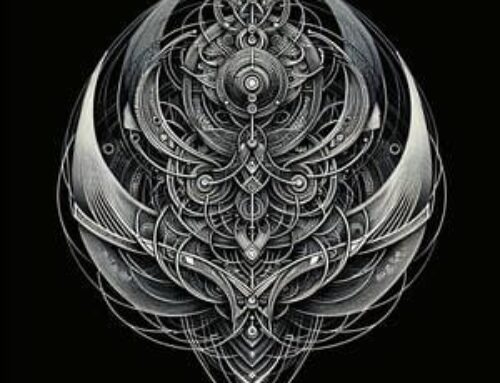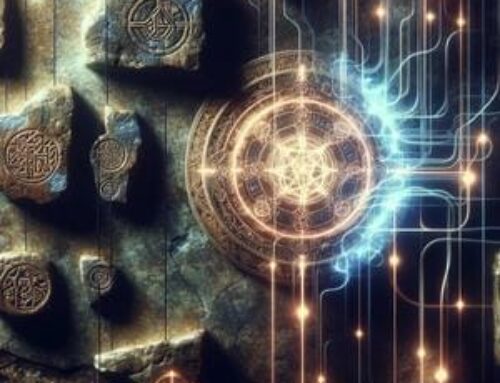Contents
- 1 Introduction to Practicing White Magic
- 2 High Magic and Transformation in Practicing White Magic
- 3 Symbolism and Ritual in Practicing White Magic
- 4 Hermetic and Kabbalistic Insights into Practicing White Magic
- 5 Conclusion
- 6 FAQ – Practicing White Magic
- 6.1 1. What is practicing white magic?
- 6.2 2. How can I start practicing white magic?
- 6.3 3. What are the key symbols used in practicing white magic?
- 6.4 4. Why is the invocation of divine names important in practicing white magic?
- 6.5 5. What ethical considerations should be kept in mind while practicing white magic?
- 7 References
Introduction to Practicing White Magic
In the arcane world of esoteric practices, practicing white magic emerges as a profound tool of spiritual elevation, embodying the highest principles of purity and transformative power. This timeless art extends beyond simple spellcasting; it is a disciplined approach to aligning with the universal energies that govern existence. Rooted in the wisdom of mystical traditions, white magic offers a path to cleanse the soul, enhance spiritual insight, and foster an environment of positive change.

Through the veil of modern perceptions, white magic retains its allure as a method for harnessing the benevolent forces of nature. Practitioners of white magic seek not only to alter their immediate surroundings but also to promote balance and healing on a global scale. This guide delves into the philosophical bedrock and practical applications of white magic, exploring its integration with Hermetic and Kabbalistic teachings, and examining the symbols and rituals that form its core.
As we traverse this enlightening path, we uncover how practicing white magic involves more than mere intention—it requires a deep commitment to the ethical use of magical power, a thorough understanding of the metaphysical laws, and a devotion to the betterment of oneself and others. Herein lies the invitation to embark on a transformative journey, one that promises to elevate practitioners to a higher plane of consciousness and bring closer alignment with the divine.
High Magic and Transformation in Practicing White Magic
Understanding High Magic
High magic, often regarded as a pillar of advanced esoteric practices, serves as a critical foundation for those dedicated to practicing white magic. Unlike low magic, which might focus on immediate, mundane effects, high magic engages with profound spiritual energies aiming to transform the very fabric of reality. It demands not only a thorough understanding of timeless wisdom but also a disciplined application of metaphysical laws.
Eliphas Levi describes magick as “The transcendental science … known always, but only to the flowers of intelligence who have understood the necessity of silence and patience” (1).
Purification and Spiritual Growth
At the core of high magic within the realm of white magic lies the process of purification. Practitioners embark on a journey to cleanse their mental, emotional, and spiritual bodies, thereby attuning themselves more closely with universal truths and energies. This purification is essential, as it prepares the mage for receiving and wielding higher powers without the corruption of personal bias or negative energies.
Aligning with Cosmic Laws
Central to practicing high magic is the alignment with cosmic laws. These laws govern the balance and harmony of the universe and dictate the flow of magical energies. By understanding and aligning with these laws, practitioners of white magic can ensure that their actions are in harmony with the will of the cosmos, thus enhancing the effectiveness of their rituals and ensuring that their magical work is benevolent and constructive.
The Role of Ethics in High Magic
High magic also emphasizes the importance of ethics. Practitioners are called to uphold a strict moral code, recognizing that the power they wield must be used responsibly. The ethical practice of white magic involves a commitment to do no harm, to seek the highest good for all involved, and to use magical abilities to uplift, heal, and protect rather than to dominate or coerce.
Transformation Through Ritual and Symbolism
The rituals and symbols used in high magic are not mere formalities but are imbued with deep spiritual significance. Each ritual act and each symbol employed in white magic is a step towards personal transformation, crafting a bridge between the mundane and the divine. Through these sacred acts, practitioners enact their will on the spiritual plane, influencing the physical plane in subtle yet profound ways.
Symbolism and Ritual in Practicing White Magic
The Power of Symbols in White Magic
Symbols are the language of the soul, a profound means of communicating truths that transcend ordinary understanding. In practicing white magic, symbols act as focal points for channeling spiritual energy and intent. Each symbol, whether it is a geometric figure, an timeless sigil, or a scriptural glyph, carries specific vibrational energies that align with cosmic forces. These symbols do not just represent ideas; they are conduits for the very forces they depict, enabling practitioners to harness and direct the energies they need for purification and transformation.
Rituals: The Art of Sacred Actions
Rituals in white magic are carefully crafted ceremonies that involve the use of specific symbols, tools, and spoken words to manifest a desired outcome. They are not arbitrary; each step, each item used, and each word spoken during a ritual is steeped in symbolic meaning and intent. Rituals create a bridge between the physical world and the spiritual realms, allowing practitioners to tap into higher energies and bring about real-world changes. These sacred actions reinforce the practitioner’s intentions, embedding them into the universal fabric.
Aligning with Natural Cycles
One key aspect of rituals in white magic is their alignment with natural cycles, such as lunar phases, solar transitions, and seasonal changes. These cycles are powerful symbols of transformation and renewal in themselves. By aligning rituals with these cycles, practitioners can work in harmony with the natural flow of energy, enhancing the effectiveness of their magical workings. For instance, a ritual performed during the new moon might focus on new beginnings and the planting of ideas, while a ritual during the full moon might center on fruition and illumination.
Creating Sacred Space
Every ritual in white magic begins with the creation of a sacred space—a consecrated area where ordinary constraints of time and space are transcended. This space is often marked out physically with symbols drawn or placed around the area, such as circles of protection that include specific magical sigils. The creation of this sacred space helps to protect the practitioner from outside energies and disturbances, creating a pure environment where spiritual work can occur without hindrance.
The Role of Personal Symbols
Personal symbols can also play a significant role in white magic. These are symbols that have a unique, personal resonance with the practitioner, developed or discovered through their spiritual journey. Incorporating personal symbols into rituals can greatly enhance the practitioner’s connection to the work, making the actions not just rituals but also deeply personal ceremonies that reflect the practitioner’s own spiritual truths and challenges.
Hermetic and Kabbalistic Insights into Practicing White Magic
The Fusion of Hermeticism and White Magic
Hermeticism, deeply rooted in the transformative principles of alchemy, is central to the practice of white magic (2). Transmutation, a core concept of Hermeticism, represents the profound transformation from a lower, baser state to a higher, purified form, mirroring the spiritual aspirations of white magic practitioners. This transformative process is not merely about personal or material change but is fundamentally a spiritual evolution, aligning the practitioner’s inner self with universal principles.
Kabbalistic Teachings and White Magic
The Kabbalistic framework provides a structured cosmology through which practitioners of white magic navigate. This journey involves the exploration of the Tree of Life, where each Sephirah (sphere) embodies specific divine attributes. The practice of white magic utilizes this map to channel higher spiritual energies into the material realm, facilitating a process of spiritual ascension and enlightenment.
Kabalistic doctrine, which is that of Transcendental Magic, is contained in the Sepher Yetzirah, the Zohar, and the Talmud (3).
The Use of Divine Names and Invocation
In both Hermetic and Kabbalistic traditions, the invocation of divine names is crucial. These names, laden with power, are used to channel divine energy during rituals, acting as direct forms of communication with higher powers. The correct pronunciation and intention behind these invocations ensure that the practice remains aligned with the ethical and spiritual standards of white magic.
Integration of Hermetic Symbols
Symbols like the Caduceus and the Ouroboros are not merely artistic representations but are imbued with significant metaphysical properties. In white magic, these symbols are employed to navigate and manifest the Hermetic principles during rituals, enhancing the practitioner’s ability to mediate between the spiritual and physical planes.
Practical Applications and Ethical Considerations
The application of Hermetic and Kabbalistic teachings in white magic goes beyond mere knowledge acquisition; it involves a commitment to an ethical framework that guides the responsible use of magical powers. This ethical approach ensures that the practitioner’s actions contribute positively to their own spiritual development and to the collective evolution of consciousness, promoting balance and healing within the wider universe.
Conclusion
In embarking upon the path of practicing white magic, one engages deeply with a tradition steeped in the profound wisdom of Hermetic and Kabbalistic teachings. This journey is not simply about learning rituals or understanding symbols; it is about undergoing a fundamental transformation that aligns the practitioner with the universal laws and higher spiritual realities.
Through the rigorous application of Hermetic principles and the structured guidance of the Kabbalistic Tree of Life, practitioners of white magic are equipped to channel divine energies and enact positive change in their lives and the environment around them. The use of divine names and the careful integration of potent symbols serve as tools not only for personal growth but also for fostering a deeper connection with the cosmos.
Moreover, practicing white magic is underpinned by a commitment to ethical integrity. It is a path that demands responsibility and mindfulness about the impact of one’s actions, reflecting a deep respect for the natural order and the interconnectedness of all things.
Seek the Light
For those drawn to the profound journey of practicing white magic, the Hermetic Academy offers extensive resources and courses to deepen your understanding and practice. Join a community committed to spiritual growth and transformation.
FAQ – Practicing White Magic
1. What is practicing white magic?
A: Practicing white magic involves the use of magical practices focused on purification, spiritual growth, and the healing of oneself and others. It integrates deep spiritual traditions from Hermetic and Kabbalistic teachings, emphasizing the ethical use of magic to align with universal laws.
2. How can I start practicing white magic?
A: Engaging with resources from established institutions like the Hermetic Academy can offer structured learning paths.
3. What are the key symbols used in practicing white magic?
A: Key symbols in practicing white magic include the Caduceus, representing duality and unity, and the Ouroboros, symbolizing eternity and the cyclical nature of the universe. These symbols are used in rituals to help conceptualize and channel the Hermetic principles.
4. Why is the invocation of divine names important in practicing white magic?
A: The invocation of divine names during rituals is crucial in practicing white magic as these names channel divine energy. Pronouncing them with correct intonation and intention acts as a direct form of communication with higher powers, aiding in the practitioner’s magical workings.
5. What ethical considerations should be kept in mind while practicing white magic?
A: Ethical considerations in practicing white magic include a commitment to cause no harm, to promote balance and healing, and to use magical powers responsibly. Practitioners must understand the weight of their actions and the karmic implications of their magical work.
References
(1) Eliphas, L. (1854). Dogme et Rituel de la Haute Magie. Paris.
(2) Rubenstein, E. (2023). Alchemy: Secrets of Consciousness Transformation. Hermetic World, Paphos.
(3) Eliphas, L. (1854). Dogme et Rituel de la Haute Magie. Paris.





